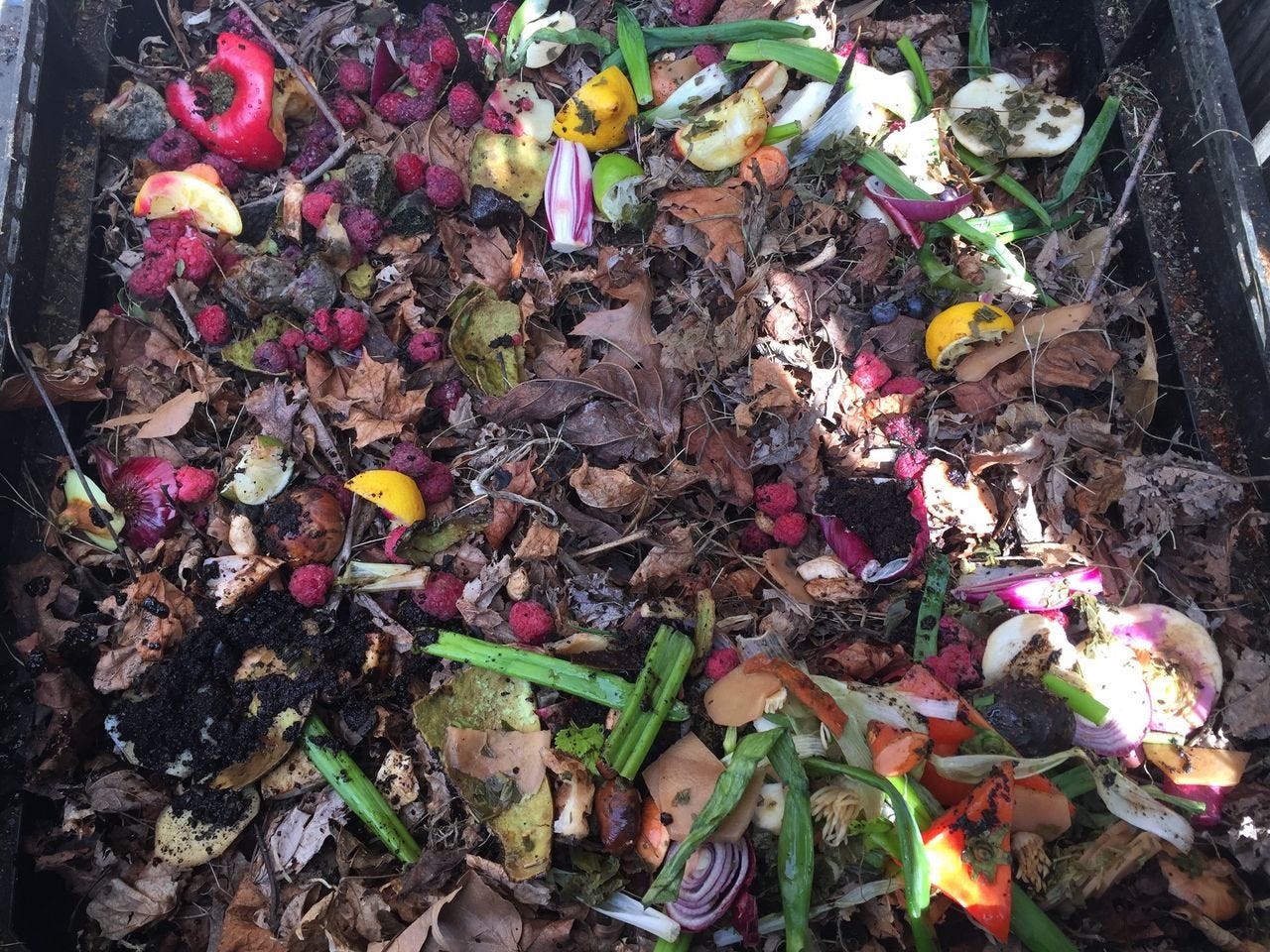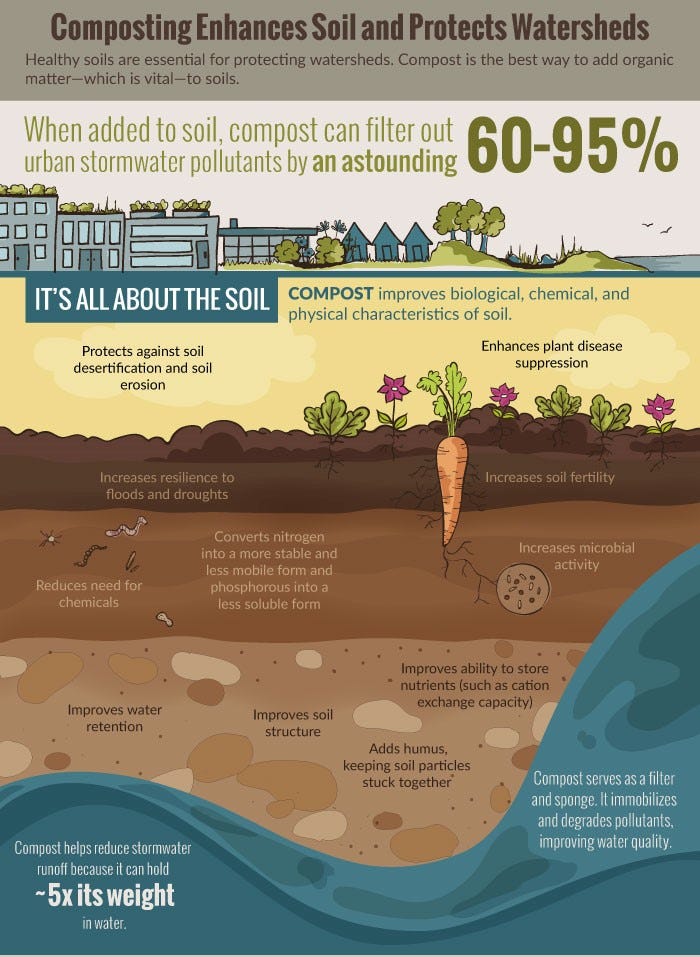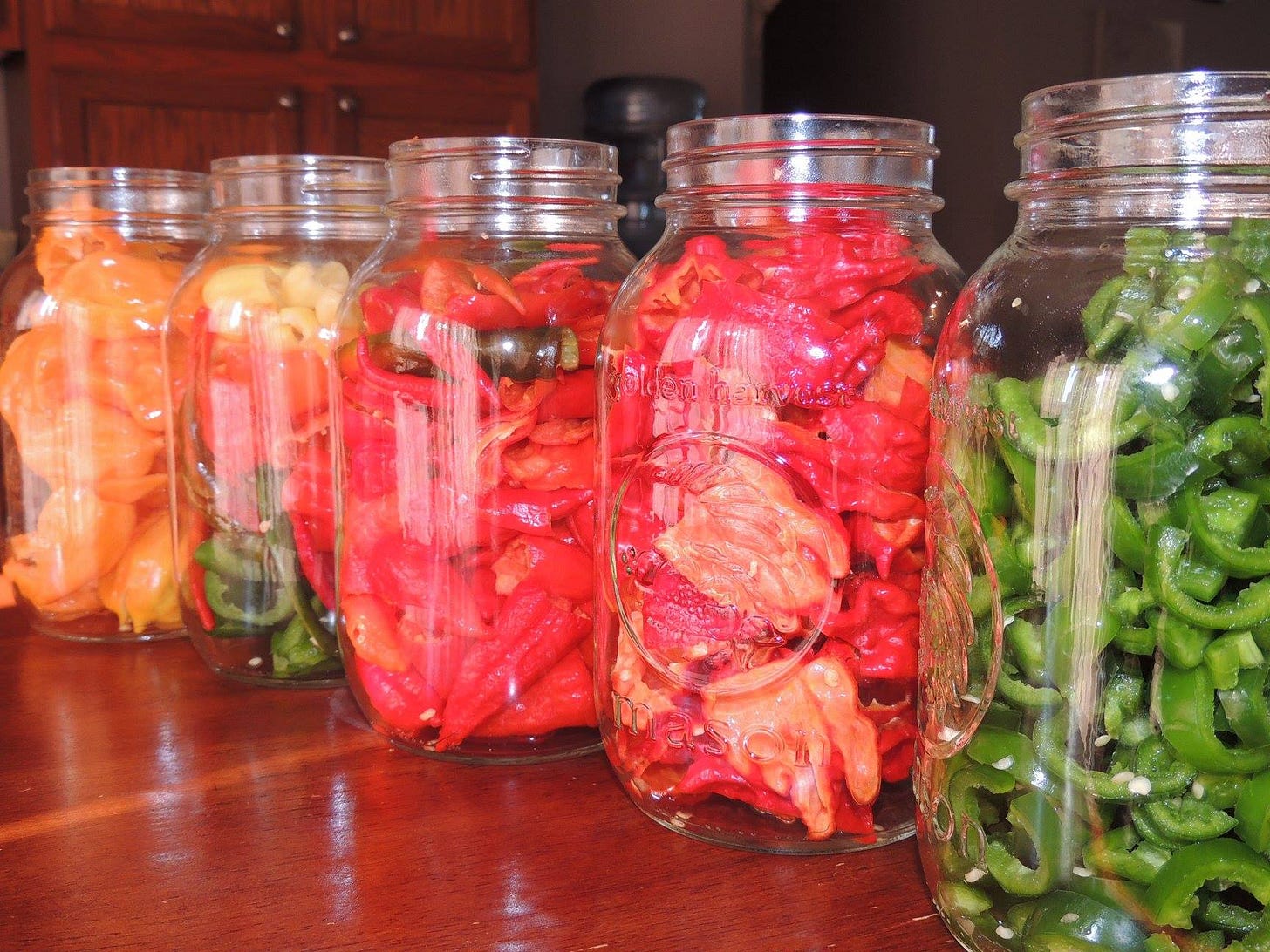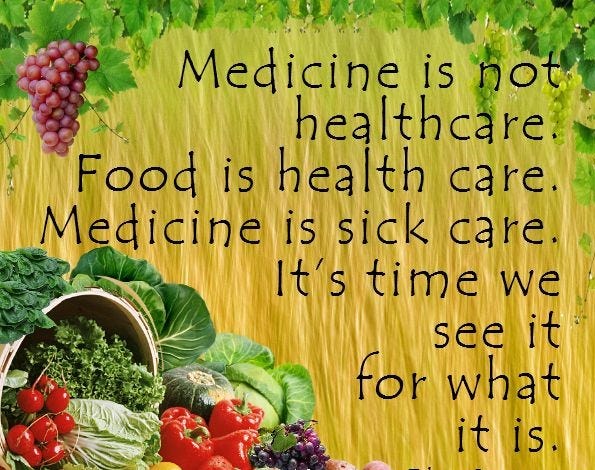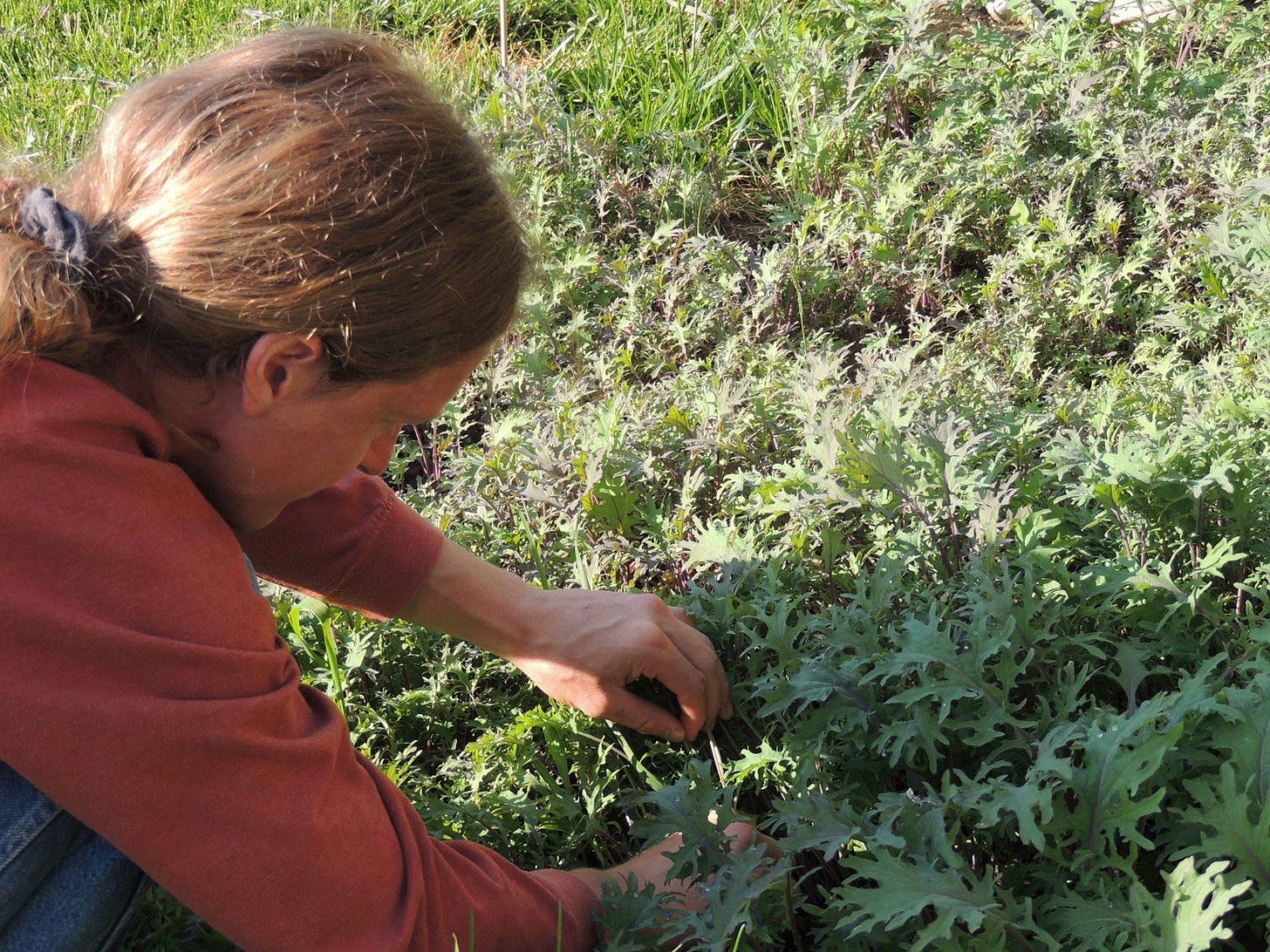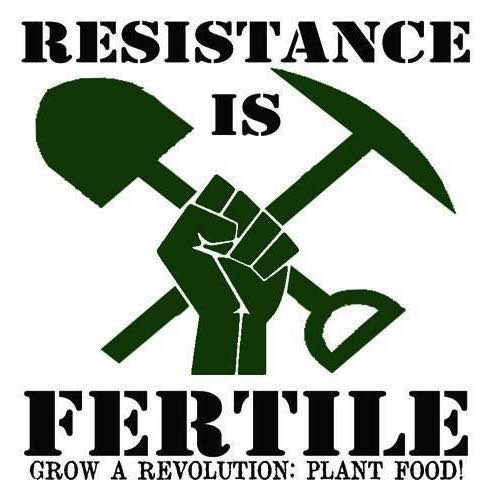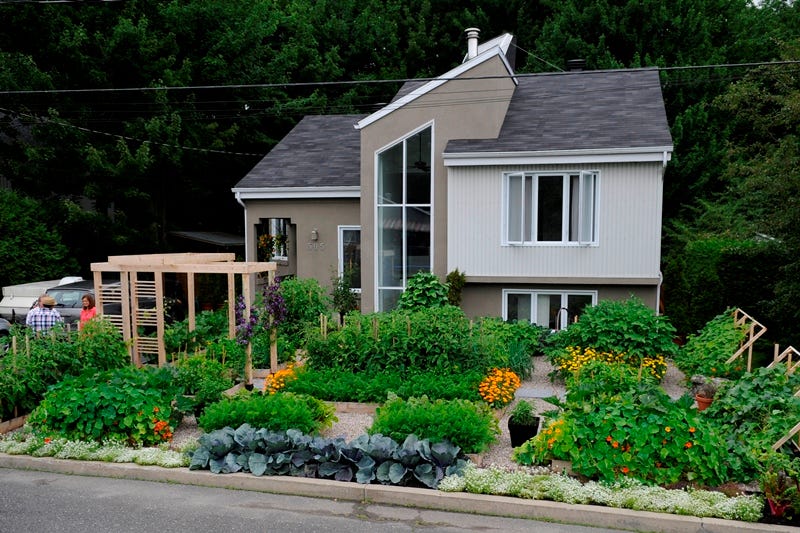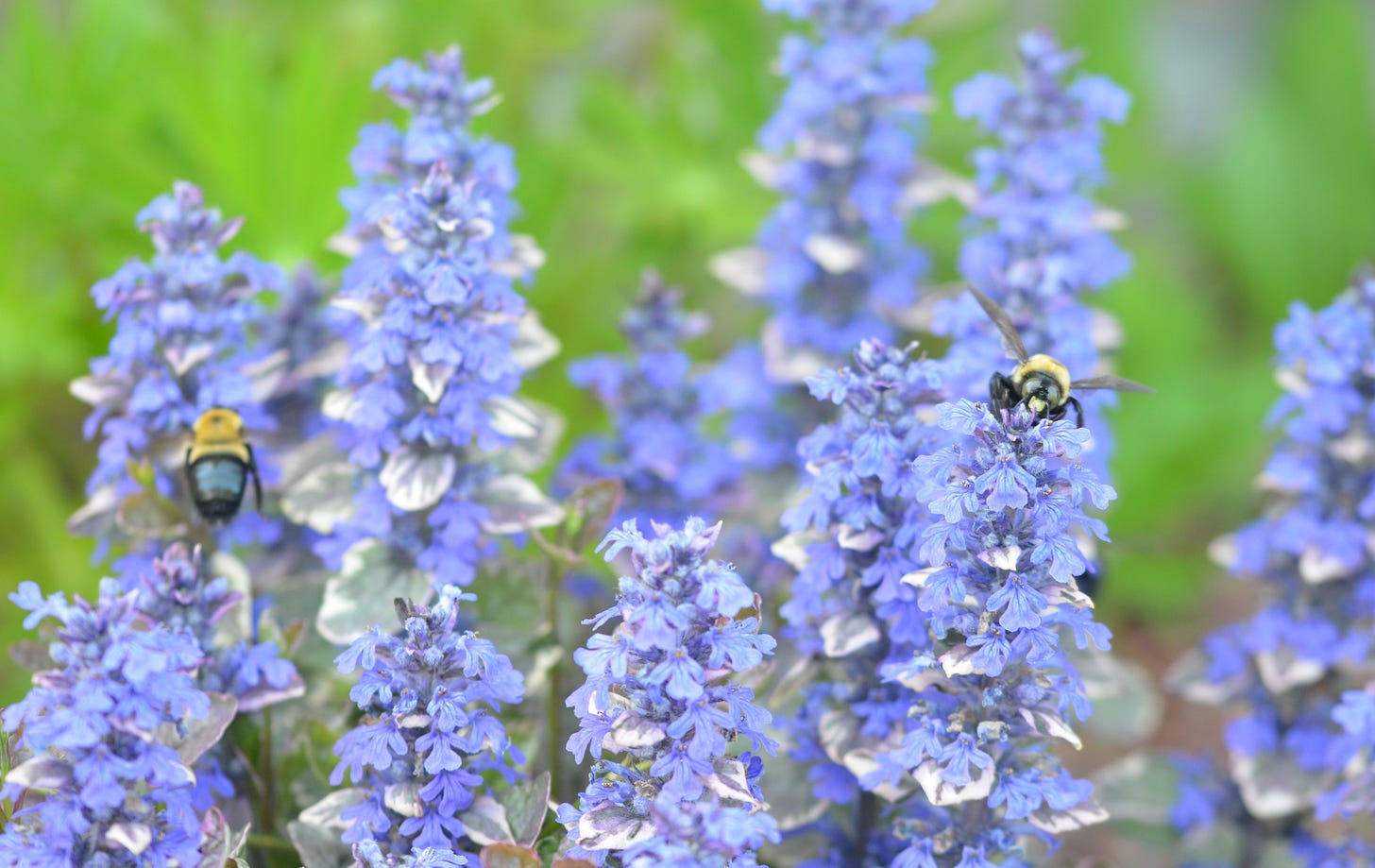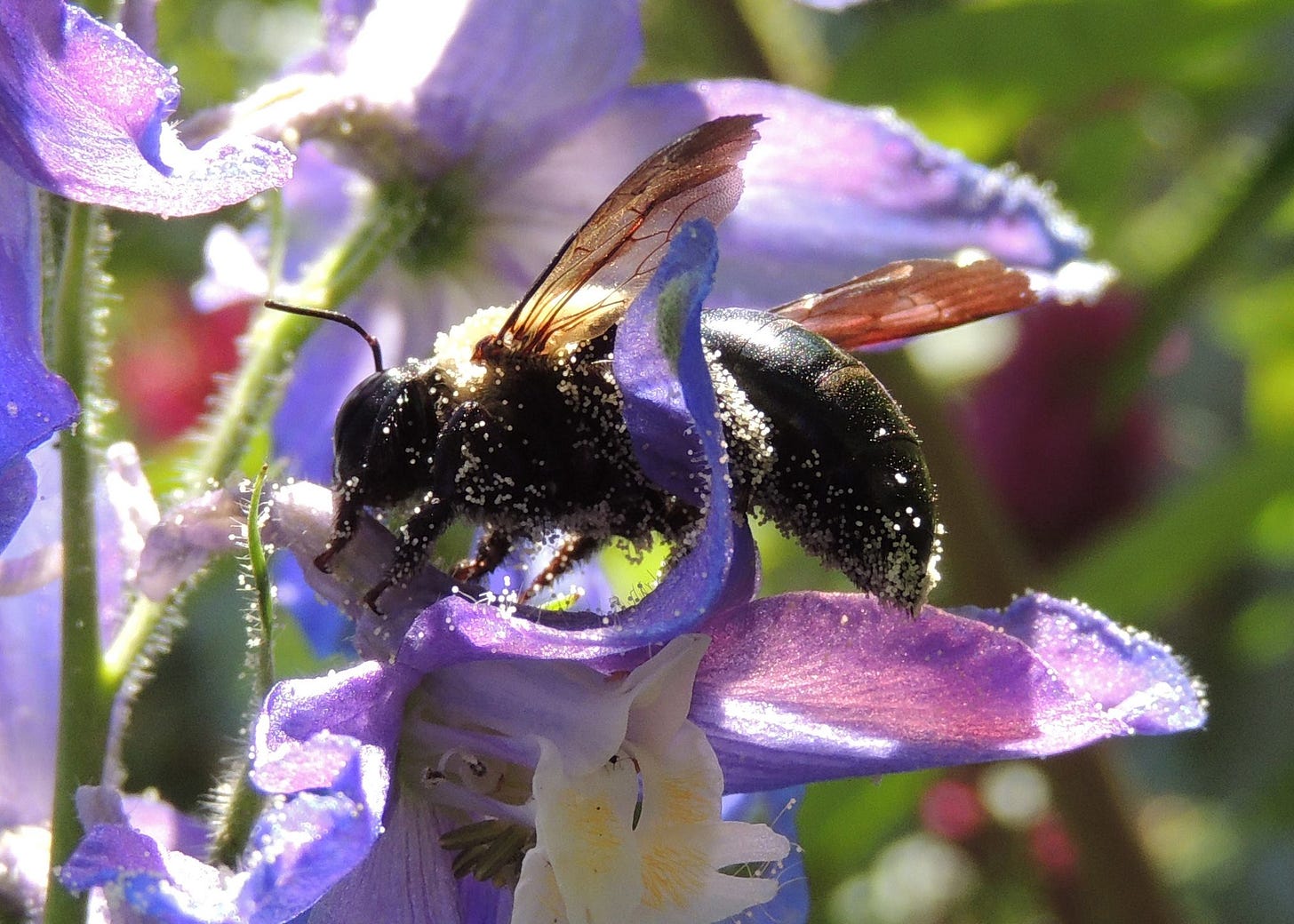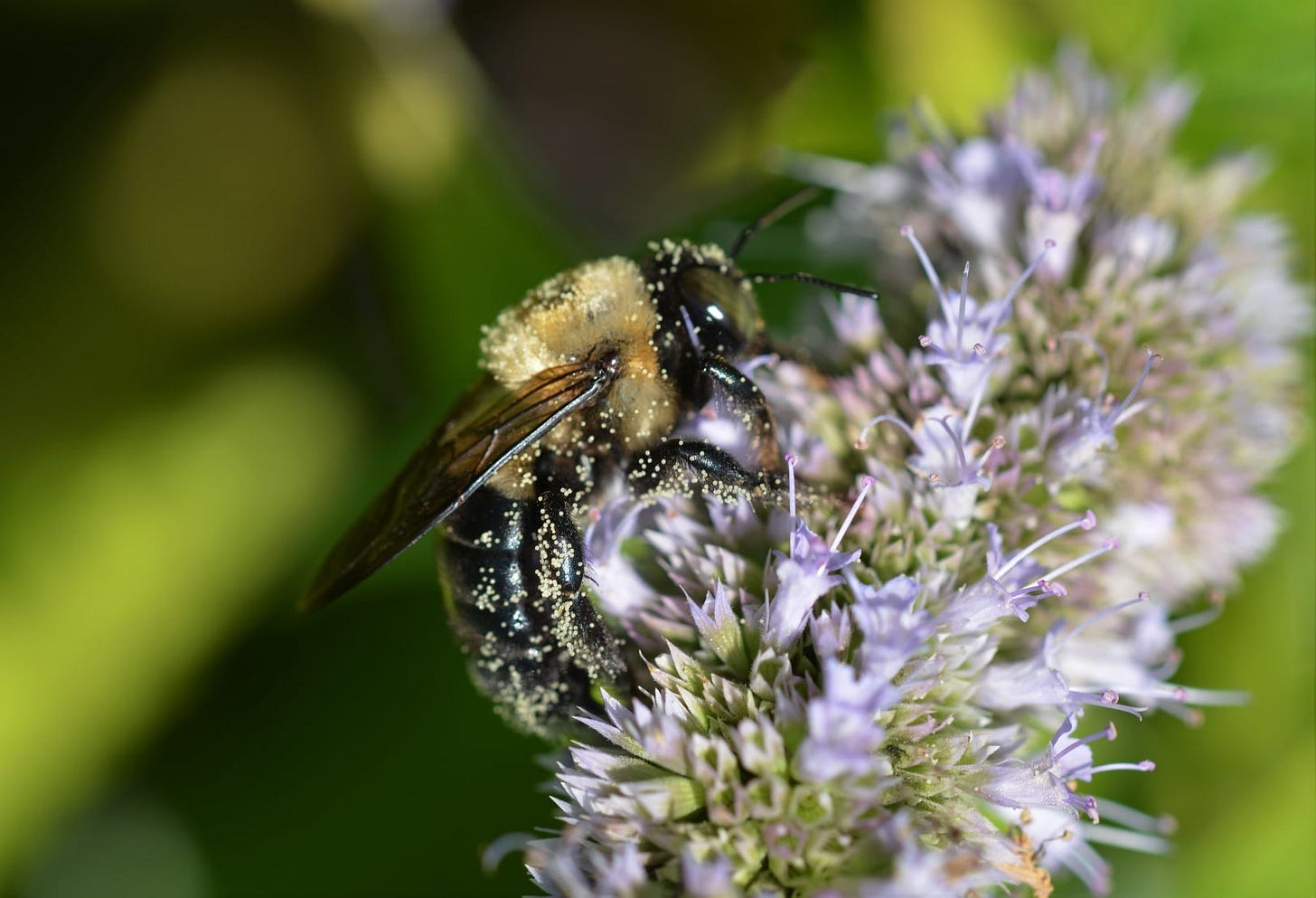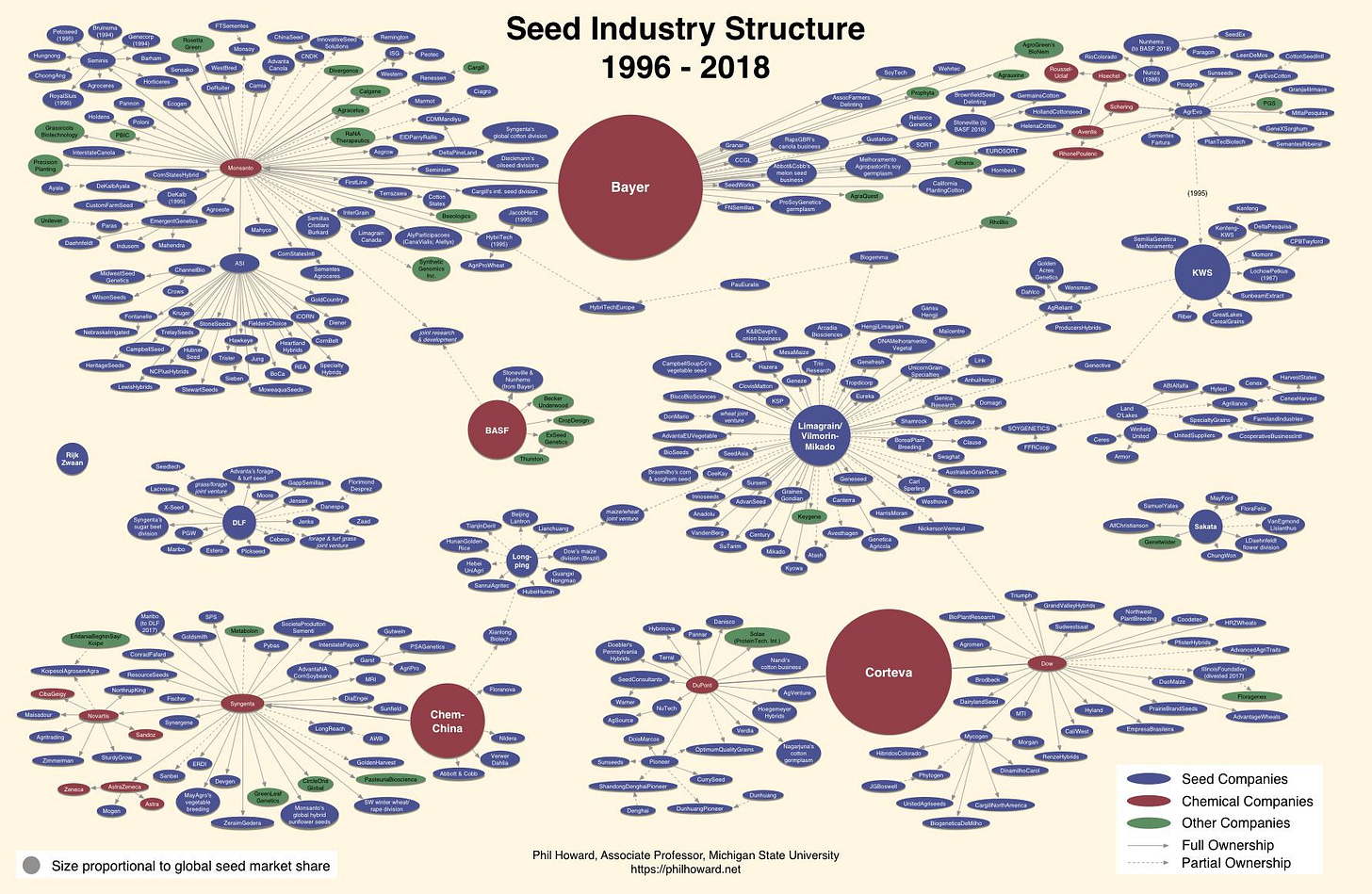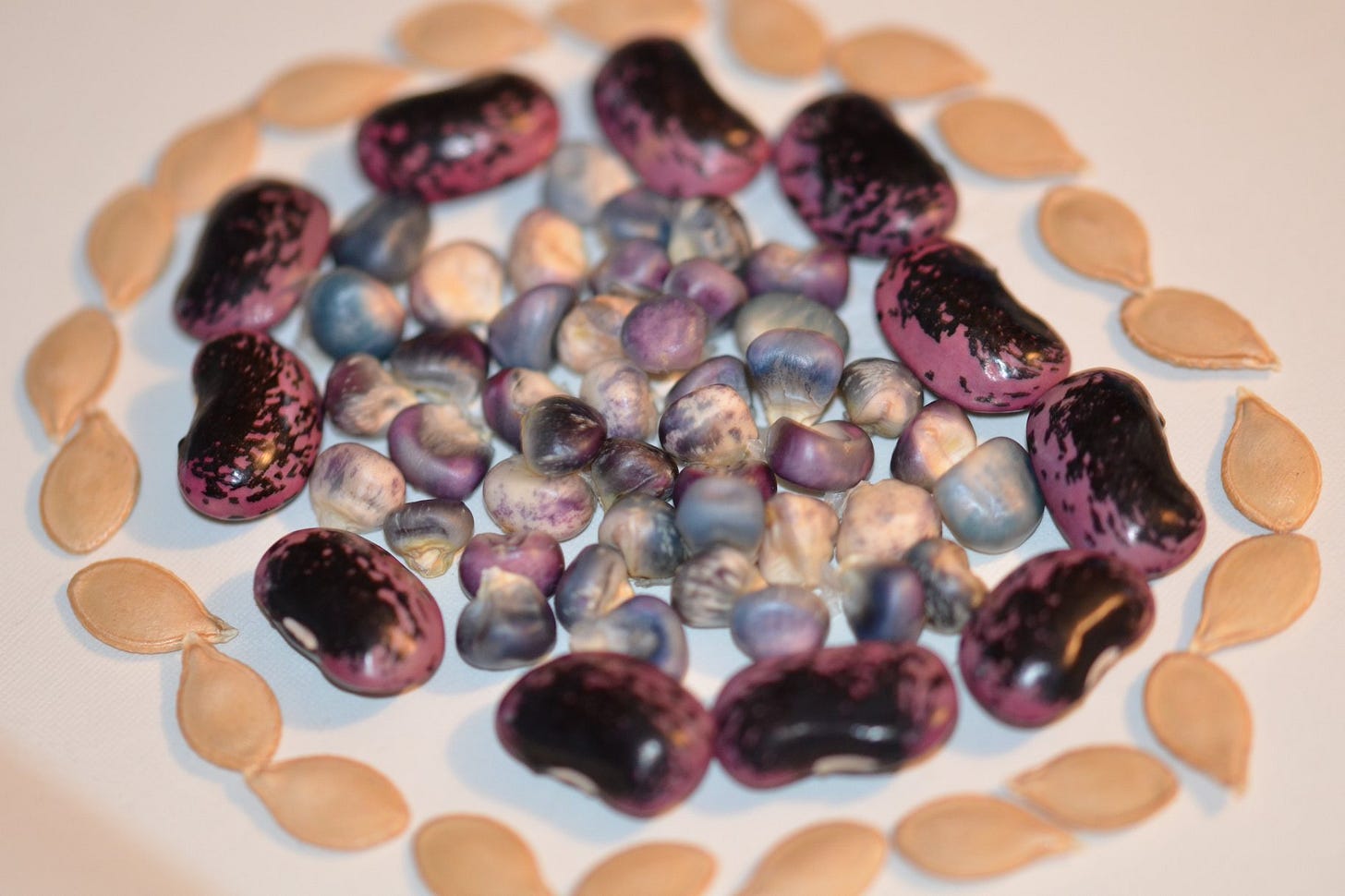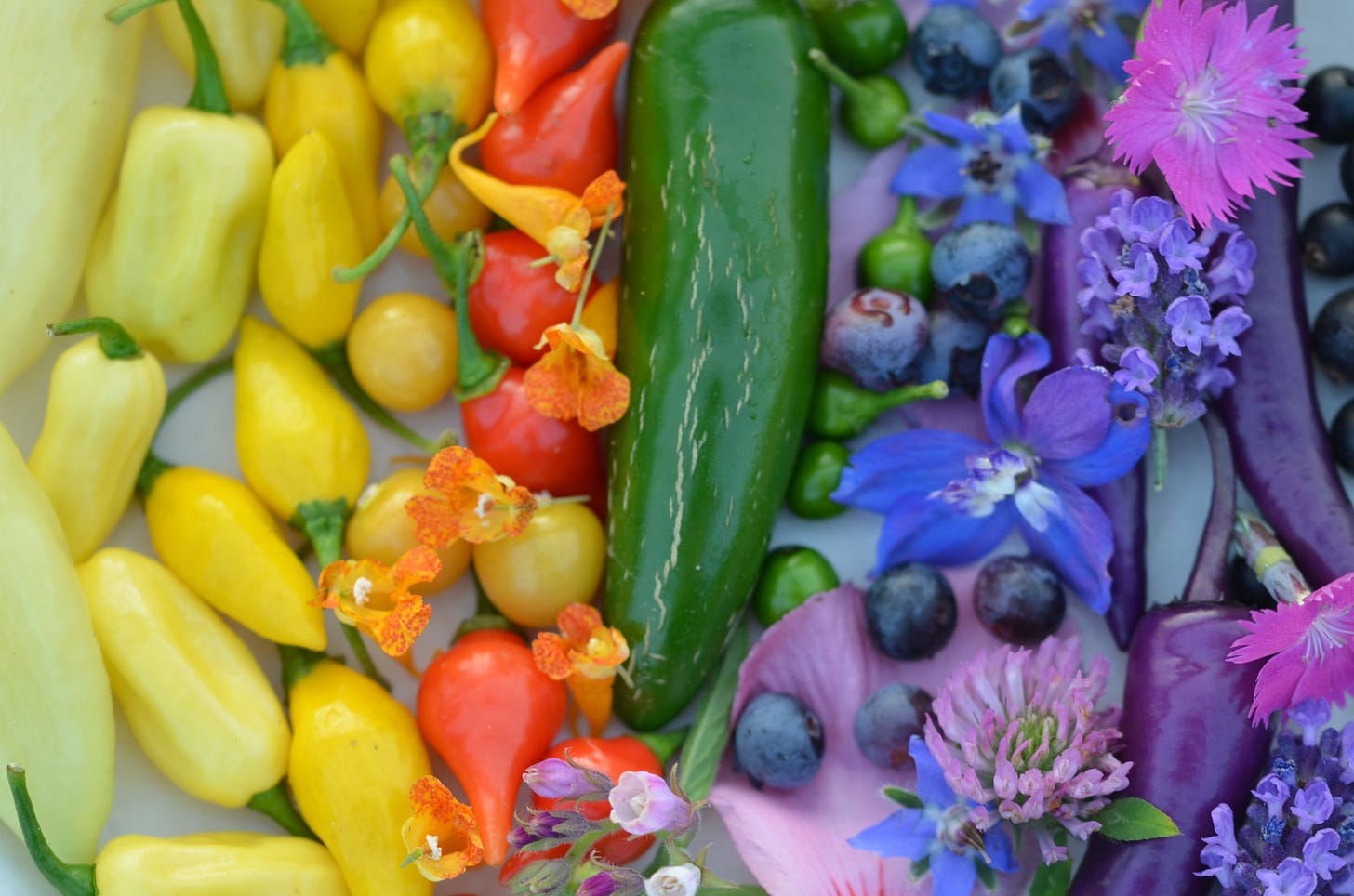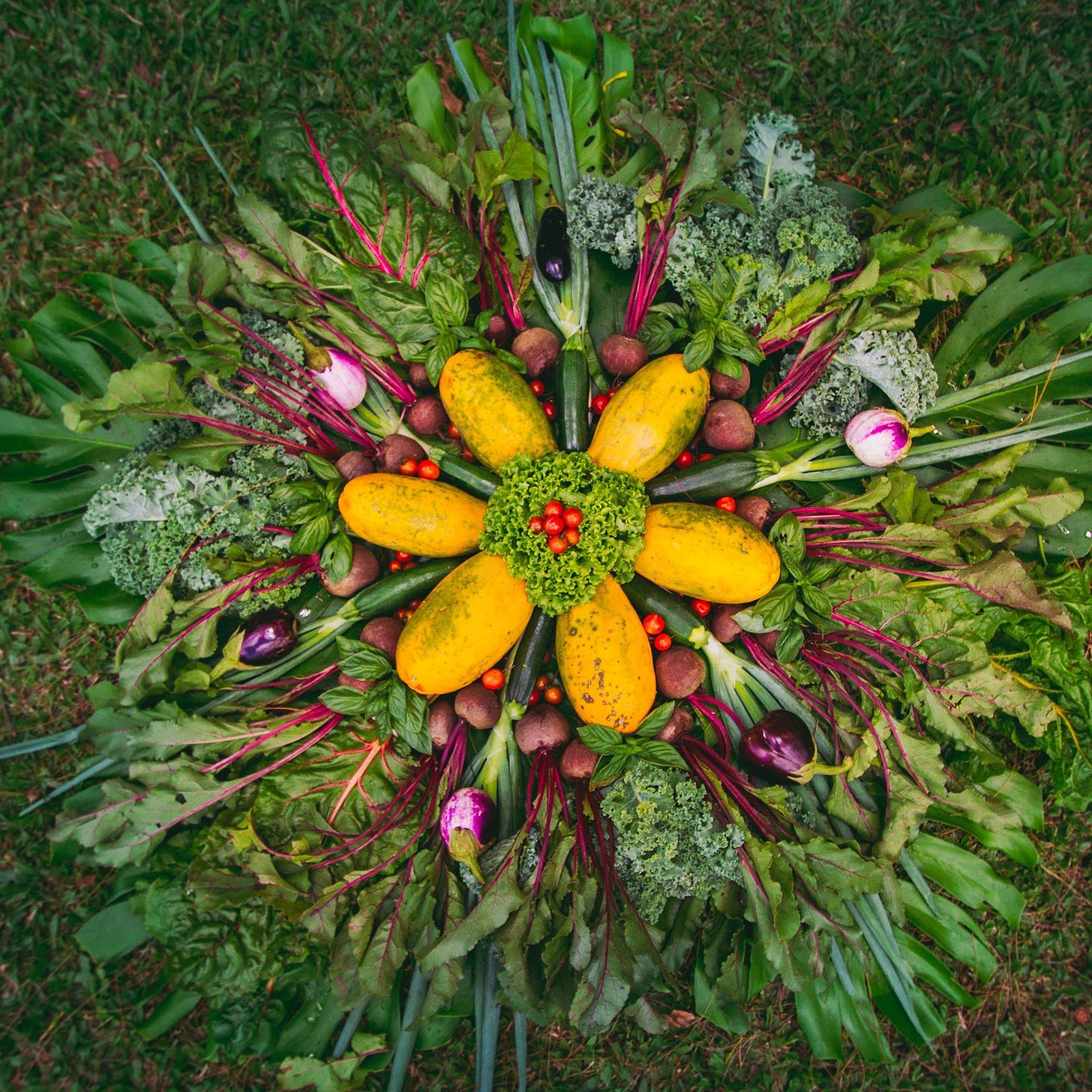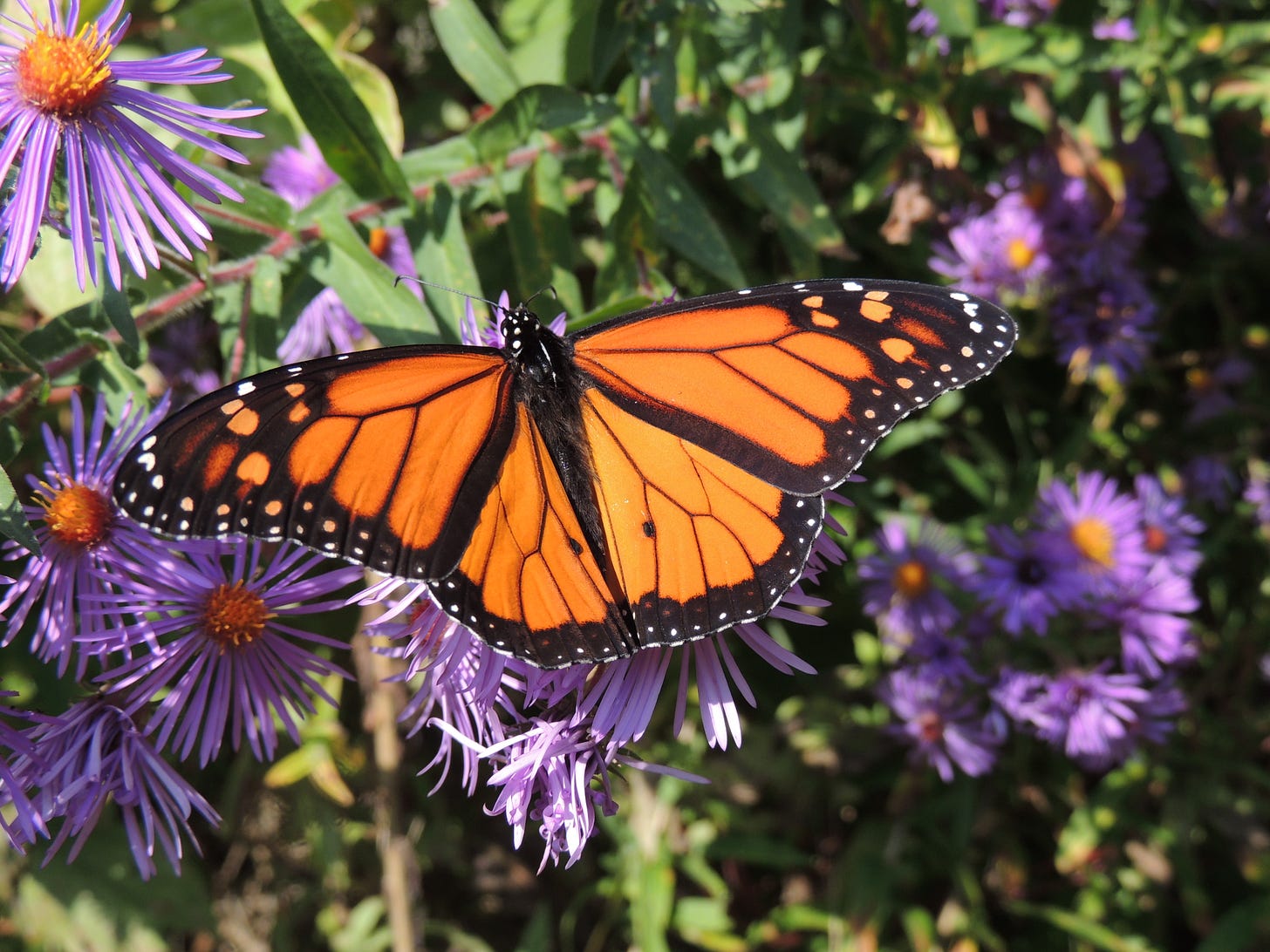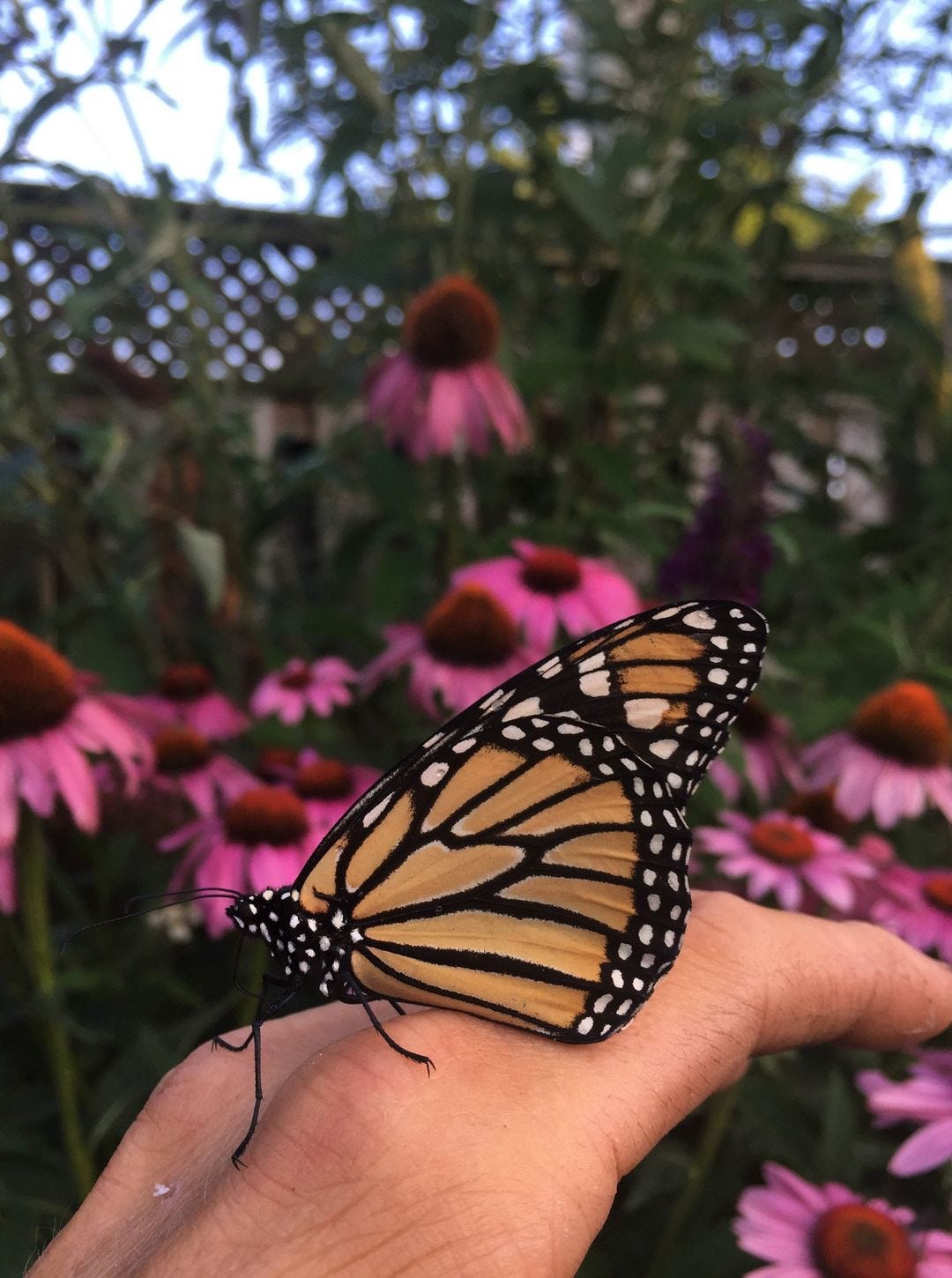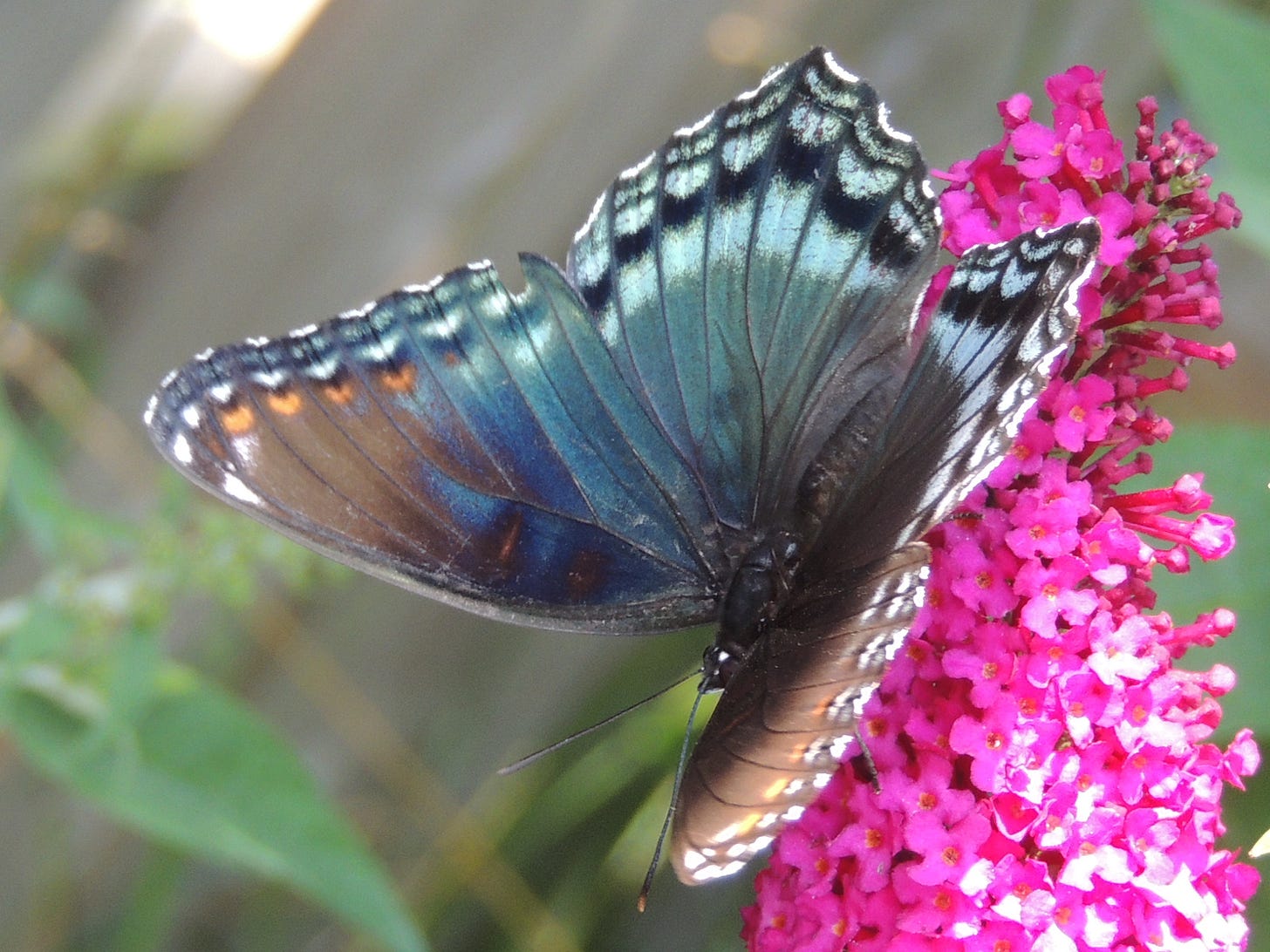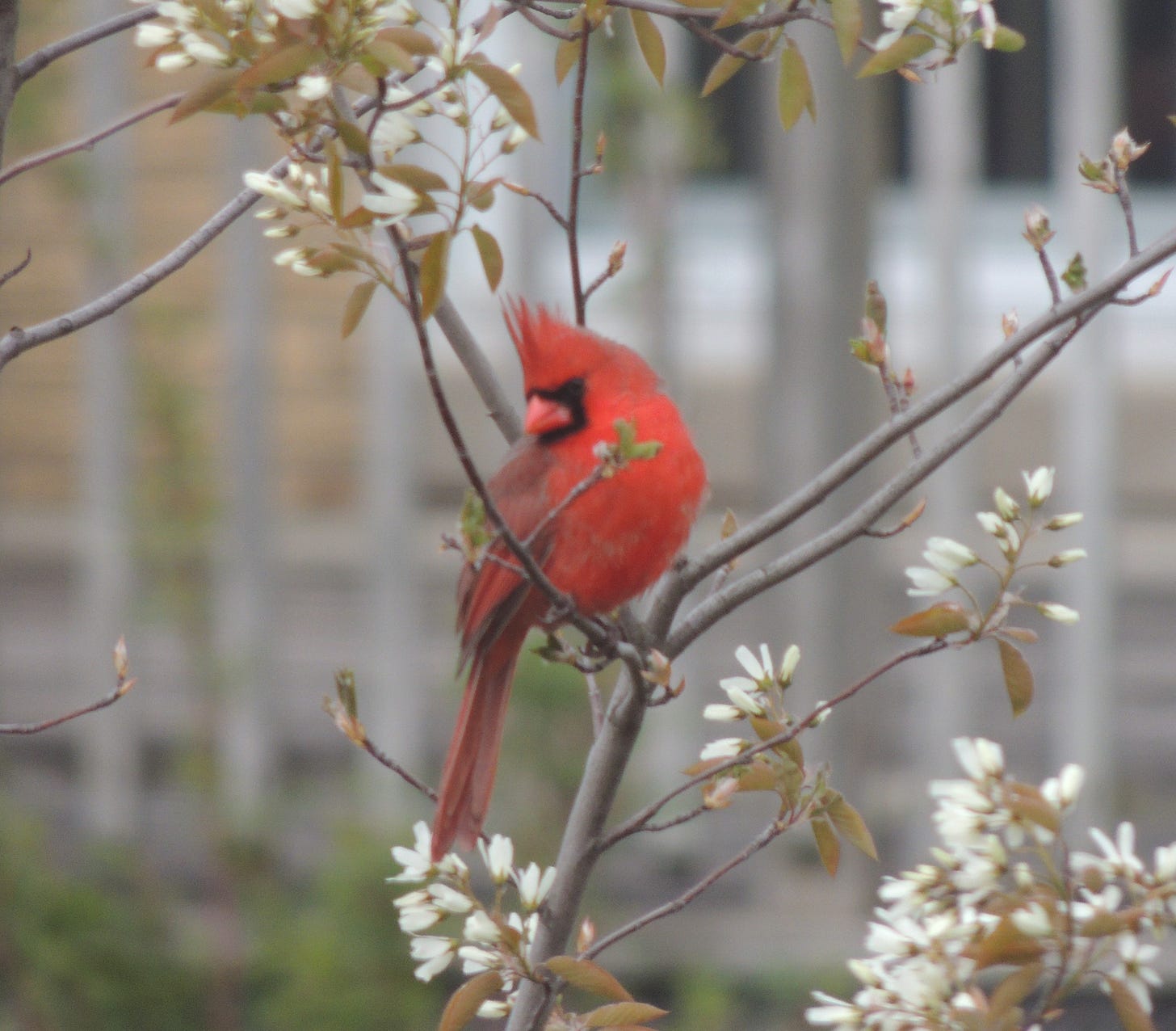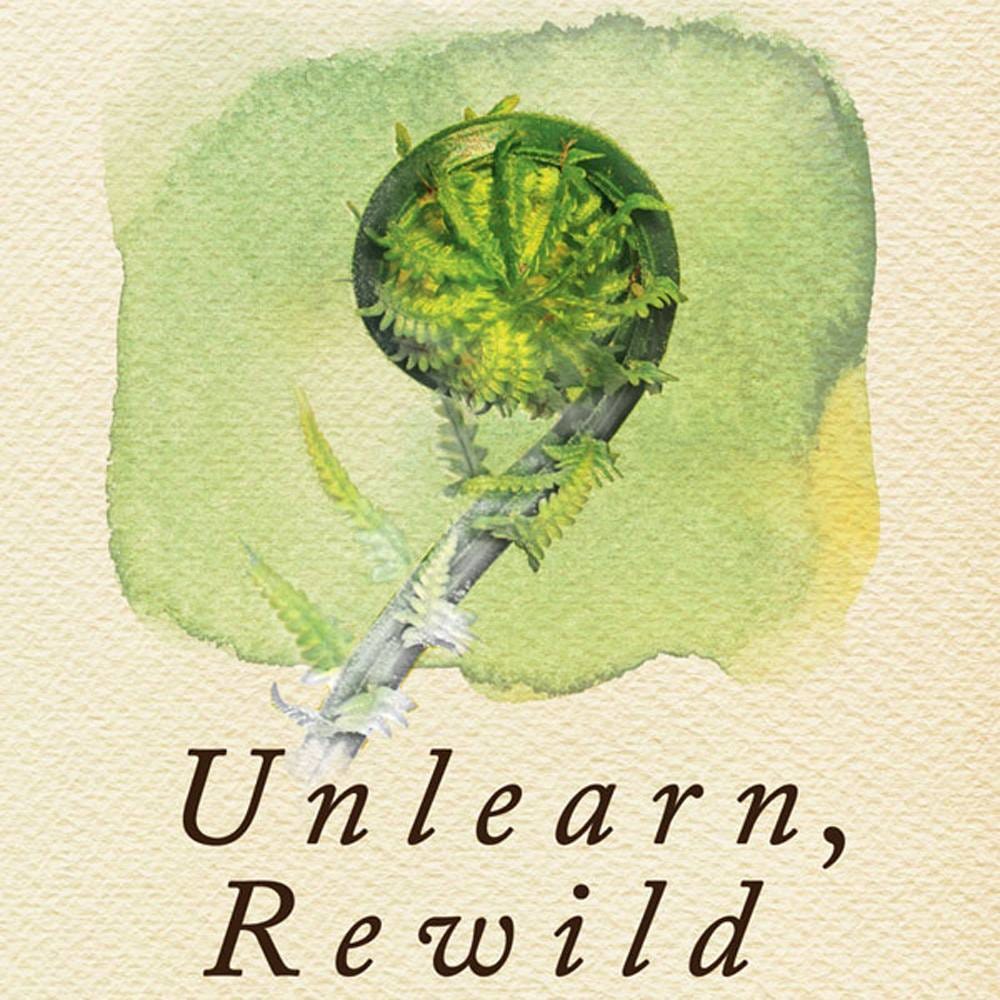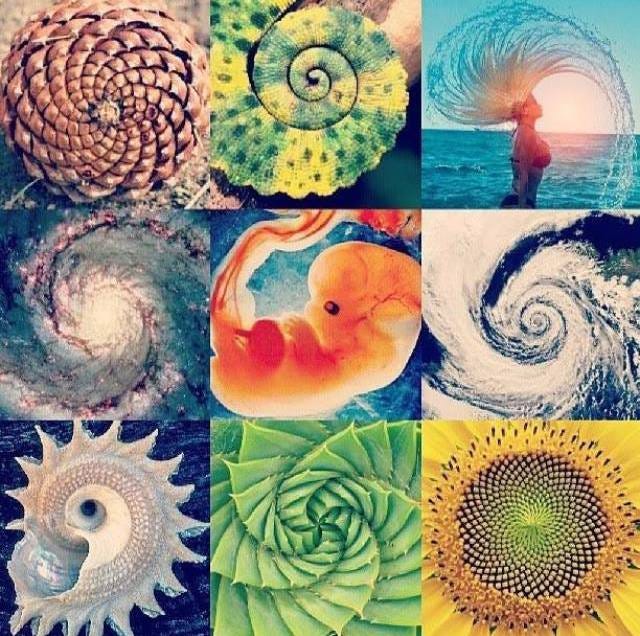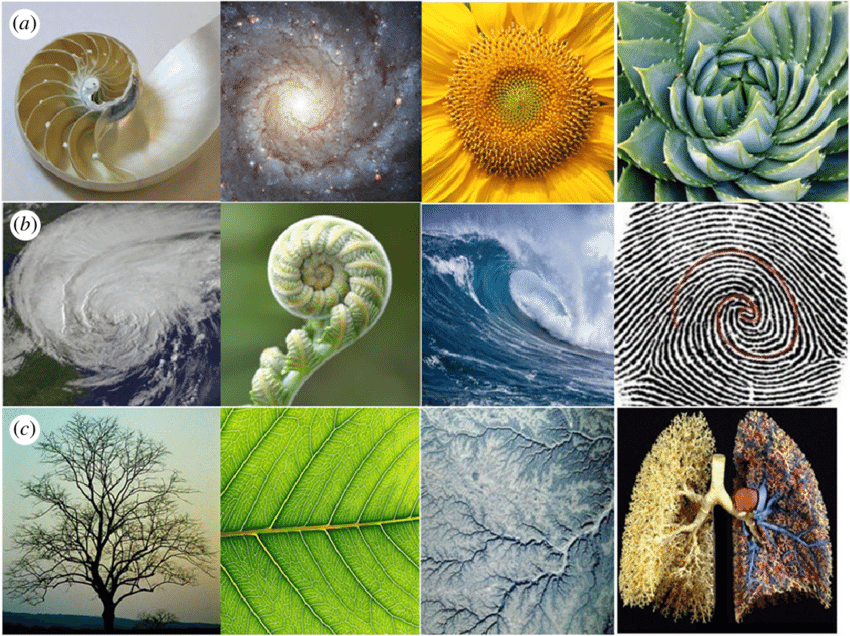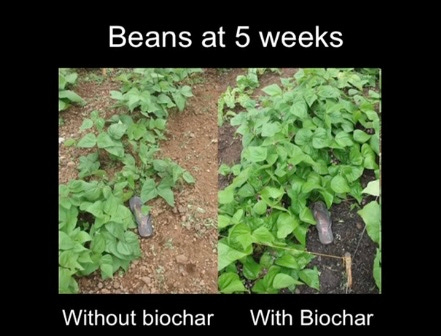IN CHALLENGING TIMES, Plant Seeds of Faith, Hope & Love AND plant seeds in the earth that become a beautiful garden that nourishes your body and soul (mind, emotions, & will) for all of your days.
Already have a garden? Then, share this with someone you feel would benefit from this info. 1 Corinthians 13:13 “And now these three remain: faith, hope and love. But the greatest of these is love”
Gavin Mounsey writes in Substack:
“If you have been paying attention to the world of finance, industrial agriculture supply line fragility, nefarious government policies (being rolled out under the guise of “sustainability”), pharmaceutical cartels schemes, soil erosion rates and the activities of the most wealthy people on Earth over the past few years, you will know very well that we have some challenging times ahead.
With all that being said, this does not mean we should begin this new year without hope or in a fearful way…
Now is the time to reaffirm our alliances with the living Earth, to nurture new symbiotic relationships with the soil, people, plants and fungi in our local communities.”
“Human empires rise and fall, and history teaches us that when they fall, it is those that know how to grow/forage for their own food, medicine and preserve it, that survived.”
23 REASONS TO GARDEN IN 2023:
1. Reciprocity: Regenerative gardening offers a way for us to give back to the ecosystem(s) that provides us with everything we need to live:
Starting a composting routine means feeding the soil life and creating valuable ‘black gold’ for building soil and increasing productivity in the garden. This means less waste ends up in the landfill, more CO-2 gets sequestered in the soil, and we are able to build rich healthy soils for supporting robust plant health (requiring less watering and yielding bigger harvests). It also means we are choosing to contribute towards a more healthy future for our children and their descendants by building the precious soils that all life depends upon to survive.
Composting is medicine for the land and medicine for the soul.
It offers us a tangible way to connect with and give back to the planet that sustains us all.
When one looks at the act of composting through a more linear or utilitarian lens it is an act that facilitates the transformation of free materials into something extremely valuable and useful for saving money on grocery and medical bills.
The value of composting is also realized in the human gastro-intestinal tract where beneficial bacteria grown from the nutrient rich composted soil helps us to digest our food and protect our bodies from invading pathogens.
In fact, every breath you take, of the oxygen that breaths life into you is the result of the plants who breathed in the CO-2 that you exhale and produced oxygen via plant photosynthesis.
2. Homegrown food is more nutrient dense:
Food grown in rich living soils contain a much higher concentration of vitamins, minerals, proteins, anti-oxidants (and other beneficial phytochemicals) than store bought food.
Most produce available in stores has lost over 40% of its nutritional value in the last 50 years because of poor farming practices, pesticides and the degradation of the food supply due to the introduction of GMO products.
Store bought GMO food is often grown in nutrient and mineral depleted soils (due to conventional degenerative agricultural practices USING THE PESTICIDE GLYPHOSATE) and the plants are already stressed due to tight spacing and the lack of beneficial soil organisms.
This leads to produce almost totally devoid of any valuable nutrition (regardless of how it may look on the outside).
When compared to crops from conventional farms, crops from regenerative agriculture farms (which means grown in living soil like you would have in your regenerative garden) had 34% more vitamin K, 15% more vitamin E, 14% more vitamin B1 and 17% more vitamin B2. The regenerative agriculture crops also had 11% more calcium, 16% more phosphorus and 27% more copper.
The study also compared wheat crops (WHEAT CROPS ARE HEAVILY LADEN WITH GLYPHOSATE TO DRY THEM OUT FOR FASTER HARVESTING).
Regenerative wheat crops were planted in a crop rotation pattern that included cover crops between crops of spring barley and winter wheat.
The regenerative wheat samples had 41% more boron, 29% more magnesium, 48% more calcium and 56% more zinc than conventional wheat samples.
When you grow crops at home in living soil (created via adding homemade compost, companion planting and mulching) the produce you harvest is significantly more nutritious than store bought.
3. Homegrown food is more delicious:
Food grown at home is more fresh, the texture, color, and flavor is of a much higher quality than food that was often picked over a month ago and shipped thousands of miles to get to your local grocery store.
Not only that but when we grow food in rich living soils the natural sugars, flavonoids and other phytonutrients produced in our crops are of a higher concentration, meaning juicier more delicious produce. This is (in part) due to the symbiotic connections between garden plants grown in rich living soils and the beneficial organisms that dwell in the soil (such as mycorrhizae, protozoa, nematodes, microanthropods. mutualist bacteria and more).
Store-Bought fruits and vegetables are bred to favor long shelf-life over flavor.
Crops produced on a large scale are bred for uniformity, aesthetics and easy harvesting (as in the case of glyphosate being used on wheat) which leaches nutrients from the soil & plants, resulting in major loss of nutrient content in store bought fruits and vegetables.
Also, many natural sugars in our favorite crops turn to starch immediately upon harvest.
There is nothing sweeter than eating a blueberry or a strawberry right after picking it!
Why? As soon as the produce is harvested, the sugars start turning to starch.
When you buy from the grocery store, there’s no way to know how long the fruit or vegetable has been off the vine or plant. The more time that elapses between harvest and when you eat, the more of the plant’s natural sugars have turned to starch.
But when you pick your own, you control how quickly you consume a fruit or vegetable at its peak ripeness.
According to a study on sweet corn from Purdue University, standard sweet corn loses 50% of its sugar content in the first 12 hours after harvest.
Store-Bought produce is also often harvested before peak ripeness (and sometimes ripened artificially).
Since most produce to be sold in grocery stores travels a significant distance, many fruits and vegetables are harvested before peak ripeness.
Some will then be ripened artificially during transport. For example, tomatoes are harvested when they are bright green. Then, ethylene gas is applied to the tomatoes during transport to artificially ripen them to red.
In modern agriculture, the soil has been stripped of natural nutrients (via degenerative practices like heavy tilling and synthetic chemicals & pesticides like glyphosate).
To make up for this lack of nutrients, growers apply synthetic fertilizers.
These chemical fertilizers provide the main nutrients plants need to grow. But, they do not contribute micronutrients or the soil microbiome plants need for a complete nutritional profile.
Another factor worth mentioning is that when chemical fertilizers are applied, crop yields increase. While this seems like a good thing, the “dilution effect” causes the fruits and vegetables to decrease in nutritional density (and flavor) BECAUSE the amount of nutrients available in the (already pesticide nutrient depleted soil) must be divided among a larger amount of plants/fruits/vegetables.
This meta-analysis from the American Society of Horticultural Science confirms through several scientific studies that the nutritional content of our fruits and vegetables has declined over the years.
Therefore combining heirloom seeds with living composted fertile soil in your garden (nurtured via creating your own compost) allows you to have access to delicious (and nutritious) food for enjoying and creating in the kitchen.
4. Growing food at home saves you money on groceries:
According to the government the average Canadian household spent $8109.00 on groceries in 2014 ( a very conservative amount in my estimation and that number is a lot higher today).
Recent reports an average family's food bill in 2022 is $14,767.00.
That number will inevitably be going up drastically in 2023 and beyond.
It is also worth considering many people are spending all that money on food that is highly processed, contains GMOs, and is chemical laden (which leads to a shorter and less full life, with big medical expenses down the road).
In 2016 Gavin Mounsey decided to keep detailed logs of everything harvested from the garden to see just how much was produced in a year.
In mid-December of 2016 the last kale leaf was harvested and her are calculations:
$3,507.51 worth of organic produce was grown in the the backyard (calculated via the per pound prices of Ontario organic market value for each crop).
Some of the crops grown included:
328.00$ worth of kale (82 bunches), 159.00$ worth of sweet potatoes (53lbs), and 204.00$ worth of beets (68lbs), only using about 1/2 of the square footage of an average sized suburban backyard and spending a small amount in the spring on soil amendments, seeds, and support posts/tape.
Spending only $20–40 on basic supplies (or just getting inventive and being resorceful to re-purpose existing ‘waste materials) and only a weekend or two preparing the soil in the garden or (growing containers on balcony, windows etc) each year, with a quick watering before work each morning will result in a significant amount of veggies (Translate that to dollars and you have hundreds of dollars worth of fresh organic produce, at least).
People often that say they cannot grow any food at home (and use the excuse of having no access to land) so when Gavin Mounsey was doing research for writing his my gardening/recipe book, he experimented with cultivating nutrient dense food and medicine indoors and in containers. He was able to grow significant amounts of ginger, kale, tulsi (aka “holy basil”), microgreens and protein rich gourmet mushrooms using only a south facing window with pots lined up and some mason jars that I filled with spent coffee grounds (for growing oyster mushrooms).
Anyone that is motivated can do that (and more) at the very least, and the immune boosting health benefits that are offered by growing a steady supply of mushrooms are invaluable.
For more info and access to materials for growing oyster mushrooms on spent coffee grounds: https://shop.mushroommountain.com/collections/indoor-fruiting-kits/products/coffee-cultivator
5. Food Security and emergency preparedness:
I grew up with a garden & a grandmother who was born in 1904—she knew how to garden & how to can fruits & vegetables. She lived through WW1, the Great Depression, & WW2.
Considering the likely reality of major crop failures, food shortages and the inevitable increase in cost of food in the near future (due to various economic dynamics that create artificial scarcity, climate instability, solar storms/EMP events that could cripple the centralized food/financial infrastructure and large scale soil depletion) the value and importance of learning to grow one's own food is immense.
We can ensure we will be able to feed ourselves and our loved ones in these uncertain times (times which indicate a high likelihood of economic, climate (Geoengineering), agricultural or political instability in the near future) through learning to cultivate nutritious food from seed, preserve that food and save seed (thereby perpetuating the cycle).
Growing your own food means you can provide for yourself and your loved ones when disruptions in centralized systems occur (as they have all throughout human history).
Saving up money for a ‘rainy day’ is not a solid way to prepare for emergencies because money has no innate value. Seeds, good soil, gardening skills, increased health/immunity, preserving experience and the symbiotic relationships and friendships we forge with neighbors and the broader community we are a part of (through sharing our abundant harvests and seeds and helping others to grow regenerative gardens) are however things that have innate value.
6. Gardening and growing your own food offers you a lasting sense of contentment and fulfilment that can not be attained by any amount of money:
Taking steps to embrace food sovereignty ia a way of living that provides a more happy, passionate and creative life.
As our basic survival needs become fulfilled through our own “hands-on work” and skills, it frees up a lot more time to pursue the things we are truly passionate about in life.
Embracing that self-sufficient lifestyle is so much more fulfilling than working ‘for the man” getting a pay check of digital fiat currency, trading it with 5 different middle men to get our food, water, energy and fulfill our transportation needs.
It really does improve not only the quality of life, but also the quantity of meaningful, healthy life.
It effects our psychological foundations as we rediscover the simple joys in life.
It helps us move away from the hyper-distracted, over-stimulated, digital chemical culture that has built up around us and allows us to let go of greed and materialism by truly coming to know the beauty of planting a seed in the soil, nurturing it to grow, and reaping what we sow.
And, most importantly, we can then teach those skills to our children and they to our grandchildren and in this way we are leaving a legacy.
7. Save money on medical bills:
Food (produce or otherwise) sold at grocery stores can be over a month old and/or nutrient depleted due to being grown in dead deficient dirt using synthetic fertilizers. Not only that but the truth is that much of that food is processed, contains dangerous GMOs, or is chemical laden and often leads to a shorter and less full life, with big medical expenses down the road.
Food grown in a garden at home with rich soils contains higher concentrations of vitamins, minerals, anti-oxidants (and other beneficial phytonutrients) that increase our health, immune response, ability to naturally detox and mitigate the onset of degenerative conditions.
By growing food at home, we ensure that our food is free of harmful chemicals that cause cumulative damage to our internal organs (damage that can lead to things like cancer, digestive disorders and neuro-degenerative diseases down the road)—which means less time and money spent on medical costs.
8. Live a longer and more full life:
There is a lot of evidence, about how gardeners live up to 14 years longer than non-gardeners.
Certainly, there are many factors involved, but I think there are some key things that gardeners do that could contribute to longer life:
For one, typically, gardening isn’t done at night, so while tending a garden, one is usually in the sun consistently. The body naturally produces Vitamin D from sun exposure, and since Vitamin D is protective against types of cancer, infections and heart disease, it is logical that those with higher Vitamin D levels could live longer.
Secondly, gardening, by its nature, means sticking your hands in the soil. While our society shuns ‘dirt’ and invents things like chemical hand sanitizer, dirt can actually be good for you!
In fact, lack of ‘dirt’, and the soil borne organisms that come with it, has been linked to higher instances of allergies and auto-immune disease.
Soil is an incredibly rich source of natural bacteria, minerals, and microorganisms. Touching the soil regularly exposes the body to beneficial (and small amounts of harmful) microorganisms that can boost the immune system. Since beneficial bacteria and gut health are so vital to overall health, it is logical that the immune boosting properties of living soil increase longevity as well.
When we eat nutrient dense home grown food we supply our bodies with the nourishment that increases not only our longevity (adding years to our life) but we also increase the quality of life in those years.
Energy levels, cognitive function, maintaining cardiovascular resilience and muscle mass are linked to diet.
When we eat fresh high quality food we increase the level of all those things, making every moment we live on Earth full of more possibilities and joy since our bodies are capable of doing so much more and for so much longer.
9. Growing our own food means we are boycotting large industries and institutions that do much harm to the Earth:
Large scale degenerative agricultural practices (which are often perpetuated via involuntary governance systems) have been a leading cause of the downfall of many ancient civilizations.
The same degradation of soil that was in part responsible for the fall of the Roman empire is amplified and increased in magnitude by our modern technology that not only involves destructive tilling practices (that destroy soil structure, beneficial organisms, leads to soil erosion and eventually desertification of entire regions) it also involves the use of synthetic fertilizers and detrimental pesticides and herbicides that poison our water, soil, air and our bodies.
The truth of the matter is that we are losing our topsoil at an alarming rate due to the activities of humans, especially in the past century. This is the result of large scale mechanized tilling dependent and synthetic petrolium derived NPK agricultural practices and in a larger context the degenerative practices spanning millenia.
Over 20 BILLION tons of soil a year is currently being lost due to the adversarial modern approach to farming which wages war on microbiology, insects, plants and fungi rather than symbiotically working in alignment with the web of life.
Heavy tilling, prolific glyphosate and other types of toxic biocide usage, synthetic petrolium based NPK inputs and monocropping have desertified huge portions of once fertile land.
When we choose to grow our own food, we are withdrawing our support from those industries as we are not buying the products produced by their destructive agricultural practices.
Furthermore, above the massive agricultural corporations is another toxic and detrimental industry, the private central banking cartel.
These are people that have invented elaborate systems so that they can print/create money which allows them to have material wealth, dominate others, and then go buy food from farmers who work the land.
They do this without lifting a finger, while the common people (most who are unaware that there are people who have set this up) end up working hard all day at a 9-5 job to get paper or digital currency from those first people, then go and give that paper or data to a farmer (or grocer who got it from the farmer) and get 'food'.
Why not skip all the middle men? Grow your own food, nourish the body and soul, and plant the seeds for not only ourselves, but future generations to have an abundance of True Wealth.
Beyond just boycotting degenerative industries and institutions, gardening (when done regeneratively and using permaculture design methods) can actually create microclimates within arid climates (literally reversing desertification) and creating self perpetuating oasis'
Morocco provides another example where, many generations ago, people were practicing something similar to what we now call "permaculture" and "food forest design" (working with nature to encourage a succession of food bearing plants that fill every niche in an eco system, becoming self-sustaining and self-perpetuating and providing habitat for many creatures as well as food and shelter for humans).
The ancient food forest in Morocco exists in the midst of a desert. Yet it is a forest eco-system that protects / builds soil, holds moisture and produces abundant food crops. (Date palms are the main overstorey species with an understorey of carob, bananas, quince, olives, figs, pomegranates, guava, citrus, mulberries, tamarinds, grapes... and many more smaller species.)
10. Growing our own food means leading by example and showing the benefits of extremely valuable life skills to the young ones who look up to us:
How nature-oriented was your childhood?
Do you remember admiring flowers in full bloom, while chasing the butterflies and bugs hovering nearby?
That may not be an experience shared by youngsters today.
A recent UK study has revealed 83% of children between the ages of five and 16 can’t identify a bumblebee.
When 1,000 children were shown pictures of native plants and animals, 82% did not recognize an oak leaf and nearly five out of 10 failed to spot a bluebell.
In this time of a hyper-distracted and over stimulated chemical/digital culture, offering avenues for children to slow down and reconnect to things that really matter in life (like gardening) is a very meaningful gift we can share with the children and future generations.
11. Exercise :
Growing your food, getting outside, breathing fresh air and being closer to nature all provide wonderful health benefits.
Caring for the soil and garden plants can be made less physically strenuous than a conventional approach using methods like no till gardening, companion planting, ‘stacking functions’ and other permaculture techniques, but cultivating the soil and growing delicious and nutritious food inevitably means moving around regularly, bending, stretching and lifting.
Regular exercise and a healthy diet prevents (and can help address and reverse) obesity which can lead to diseases such as cancer, heart disease, and high blood pressure.
12. Growing your own food and medicine in a garden sabotages the plans of the megalomaniacal oligarchs that want to control every aspect of our lives:
Do you want to know even more about the megalomaniacal oligarchs plans & the status of the control matrix they are implementing?
Read this:
Saving heirloom seeds is a HEROIC act of sabotage BECAUSE it throws a monkey wrench into the machinery of the global corporatocracy (that wants to own all seed, to buy out and shut down the small family owned companies, to patent and perpetually profit from their false claims of owning intellectual rights to the genetic fabric of life).
We can effectively sabotage nefarious plans of the global corporatocracy by engaging in what Vandana Shiva calls “Seed Satyagraha” in each of our households.
https://seedfreedom.info/campaign/seed-satyagraha-civil-disobedience-to-end-seed-slavery/
By saving heirloom seed, growing and preserving food and medicine from our garden, we are engaging in an act of HEROIC sabotage.
The oligarchs/global corporatocracy are working diligently to cripple the conventional farmers and global food supply via a variety of means.
Creating decentralized food systems that are self-perpetuating (regenerative gardens and/or food forests) sabotages their plans to create a situation where the population is dependent on their centralized food infrastructure (WHICH helps to de-fang their plans to use CBDC and social credit tyranny to force compliance through the dependence of the masses on their systems for our basic necessities).
PLEASE READ:
Our self sufficiency is a form of HEROIC sabotage which cripples their ability to enforce their totalitarian schemes on future generations, BECAUSE through the act of saving seed & sharing it (and regenerating the earth at the same time), we begin to create communities that can be like islands of resilience and abundance that will be immune to the financial coercion tactics and digital shackles that the oligarchs/global corporatocracy are on the verge of fully implementing.
Each of us can do this.
We can take back our food sovereignty & establish our own parallel micro-economies in our own local communities which will sabotage their plan to make us all into totally dependent consumers of mass produced gmo garbage ‘food’ purchased with digital money that would shackle us & coerce us into their control matrix.
13. Gardening Strengthens, Nourishes and Heals & CREATES FREE, LOCAL PARALLEL ECONOMIES/Communities:
the above image is from the Food Is Free Project website (created by John VanDeusen Edwards, shown in the right of the pic)
Growing food brings families together in the garden and at the table.
The tending and harvesting rituals slow down one's lifestyle and encourage more home-cooked meals.
Gardens can also be social magnets that get neighbors talking over the fence, connecting families to their communities.
Through cultivating and nourishing the soil, connecting with our neighbors and sharing the resulting abundance we begin to build resilience, symbiosis and lasting bonds throughout our community as a whole.
In a time when propaganda on the tv, various digital addictions (video games, social media etc) and a materialistic lifestyle has come to dominate the lives and thinking of many in communities in the west, planting and sharing the abundance from one’s garden can serve as the most valuable and desperately needed kind of medicine for a world that needs to reconnect to the land where their food comes from.
There are many beautiful examples of this beginning to happen all over the world… a few of those include the Food Is Free Project, the “We Are Human, We Are Free” worldwide nonviolent resistance movement, the Grow Free movement, John D. Liu's Ecosystem Restoration Camps and The R-Future Conference.
14. The more garden you grow, the less you have to mow:
First of all, why do we even have front lawns in the first place?
People rarely use that space to enjoy with their family and yet they spend large amounts of time and money maintaining them.
The History Of Front Lawns:
In the 17th century in England, we first saw the deliberate growing of trimmed grass by the wealthy and the aristocracy as a show of affluence.
During those times, land was a valuable resource, as it was used to grow food, which provided a source of nutrition and a source of income.
For a wealthy landowner to simply grow grass was a show of extravagance, flaunting the fact that they had land to waste as they pleased.
The enormity of such a status symbol may not be immediately obvious to us in our current day and age until we realize that lawn mowers did not exist at the time!
These lawns were cut by hand — by servants using scythes, sickles and shears. The amount of labour involved in maintaining a large lawn was considerable, and only the wealthiest in society could afford to pay people to carry out this work.
The first mechanical lawn mower was invented in 1827 and patented in 1830 by engineer, Edwin Beard Budding (1795-1846) from Stroud, Gloucestershire, England.
After the lawnmower was invented, having a lawn no longer remained the mark of wealth and status that it once was, but this status symbol now became accessible to the masses.
From that time onward, we’ve just kept on growing lawns in our front yards, forgetting that they were once grown as a symbol of wealth. Just another one of those unquestioned traditions that people blindly follow without knowing why.
Essentially, Hundreds of years ago, grassy lawns originally became popular to prove a person was wealthy enough to waste land rather than farm on it.
Here are some of the reasons we need to stop obsessing over perfect lawns, and make the move to regenerative gardening
Noise and air pollution – Lawn mowers and similar equipment account for 5 percent of air pollution, and a fair amount of the noise pollution as well.
Water wastage – Lawns require lots of water to maintain their perfect green color, accounting for 30-60% of all urban fresh water usage. Generally, the more that an area is water-insecure or stressed, the more that lawns and landscaping contribute to the problem by relying on the already limited water supply to not shrivel and die.
Water supply – The water supply in the ground is then poisoned as the toxins seep into our groundwater, into our tap water, and then into us through various ways. Even if you don’t drink tap water, we bath, shower or swim in it most often. The skin is our largest organ and absorbs toxins quite easily.
Higher concentration of poisons – Homeowners spend billions of dollars and use 10 times the amount of pesticide and fertilizers per acre on their lawns as farmers do on crops. Even though agricultural land takes up much more space than lawns, pesticide usage in urban areas is far more concentrated.
Toxic toll on pollinators – The poisons sprayed on lawns are killing other plants/weeds that bees need to survive. As well, studies have shown that the bees are picking up the toxins, which is killing them directly, as well as the bees are spreading the toxins around.
Pets, wildlife and children – While they may tell us to stay off the lawn for a few days after spraying, the poison doesn’t just disappear. Our pets, wildlife and children end up absorbing the poison by just touching the lawn after.
Soil – Monocrops such as grass destroy the soil, which permaculture repairs the soil.
Clearly lawns are not the answer, even if you take the poisons out—Loss of pollinators (bees) from removing the other plants/weeds, wasting water, and the destruction of the soil are still problematic.
Its time to grow food my friends!
Wouldn’t you rather look out at a bunch of vegetables, fruits and flowers growing in your garden than HAVE TO SPEND MONEY & TIME ON MOWING a wide expanse of grass that doesn’t feed you anything?
15. Help the bees:
When you grow a wide variety of heirloom organic vegetables, herbs, berry bushes and/or fruit trees, you are helping the bee population to have a diverse source of nectar from the flowers. Bees (and other pollinators) are essential to our continued survival and way of life. Without bees to pollinate our fruit trees and vegetables large portions of the population would starve.
Globally, honey bees are disappearing at an alarming rate because of the spread of urban development, increasing pesticide and chemical use, parasites, disease and loss of habitat. Bees struggle to survive in our cities and suburbs because of these impacts
Why are bees so important?
1/3 of all food in the world is dependent on pollination
3/4 pollination of main crops are pollinated by insects (most efficient are honey bees)
so many vegetables and fruits require bees for pollination
without bees our food sources would reduce to some grains, a few fruit species and fish.
grazing animals rely on clover and other bee pollinated pastures
the more bees in your garden, the bigger your harvest will be
What do bees need?
range of flowering plants makes them stronger and healthier
plants flowering throughout the year
open simple flowers – these are easiest for bees to collect nectar and pollen from – avoid modern hybrids with many petalled, dense flowers
access to fresh water
habitat and protection – logs, hollows and homes
In recent years, the bee population has been declining due to the widespread use of toxic herbicides and pesticides like glyphosate aka “round up” and the destruction of their natural habitat. The more diverse and continual pollen available from a vegetable/herb garden (or food forest) makes for healthier bees and in turn more food for your family
Bees have good colour vision and especially like blue, purple, violet, white and yellow. Create floral bull’s eyes — plant a single species in clumps about four feet in diameter instead of in scatterings.
Many bees feed on one or a small number of plants. Include plants with a variety of flower shapes and sizes to attract a greater diversity.
What plants attract bees?
Some Herbs That Bees Love:
Basil, chives, comfrey, coriander, fennel, lavender, lemon balm, mint, mustard, oregano, parsley, rocket, rosemary, sage, tulsi, thyme, yarrow, Borage, and anise hyssop.
Veggie Flowers:
Brassicas, capsicum, chilli, cucumbers, leeks and onions, pumpkins, squash and tomatoes
Flowers
Alyssum, calendula, cornflower, cosmos, daisies, echinacea, geranium, marigold, roses, salvia, sunflowers, zinnia, lavender and many more!
Click here for more info on how to create a bee-friendly garden.
16. Homegrown food contains more energy:
Beyond just containing more nutrients and flavor, food grown in rich fertile soil with love also possesses energetic attributes that the store bought (mass produced/hydroponically grown) food does not.
Many ancient traditions express a shared concept that as the foundation of all life is a field of energy. This field of energy has been given many names, Qi, Prahna, Vibration etc.
The plants and fungi we eat all contain this energy which scientists are now beginning to be able to measure this energy field with experiments that show how non-physical stimuli like music, thought, emotion or words can influence the way plants grow.
When we plant a seed in the rich living soil in our garden and nurture that life to grow, the resulting food we harvest is vibrating at a very high level on the quantum scale.
This becomes apparent when biting into a juicy homegrown tomato or cucumber and experiencing, not only a burst of flavor and other sensory pleasures, but also a burst of uplifting energy.
17. Soil microbes have anti-depressant and cognitive function boosting capabilities:
Working in the garden (touching and smelling that rich soil) has now been proven to have benefits to the human brain and immune system.
Gardeners have been saying that working with their hands and the smell of the rich earth makes them happy for centuries and now science has discovered one of the reasons why that is!
Interacting with diverse array of beneficial microscopic organisms in the kitchen (with fermented foods) and in the garden (through working with living soils) increases the resilience of your body through the symbiotic relationships that take place between those microbes and your cells in your gut and in your blood stream/brain.
Eating fermented foods... touching and smelling rich living soils is a crucial symbiosis which produces regeneration through receiving data on a molecular and cellular scale through our microbiome.
Each handful of living soil you lovingly gather up to support your seedlings is opening up a symbiotic dialogue between your cells and the more ancient organisms that call this world home.
Get outside, work in the soil and get your hands dirty more often this year to improve the function of your immune system and brain.
Articles and research:
https://qz.com/993258/dirt-has-a-microbiome-and-it-may-double-as-an-antidepressant/
https://www.gardeningknowhow.com/garden-how-to/soil-fertilizers/antidepressant-microbes-soil.htm
https://www.discovermagazine.com/mind/is-dirt-the-new-prozac
Soil Bacteria Work In Similar Way To Antidepressants:
https://www.medicalnewstoday.com/articles/66840#1
Identification of an immune-responsive mesolimbocortical serotonergic system: Potential role in regulation of emotional behavior:
https://www.ncbi.nlm.nih.gov/pmc/articles/PMC1868963/
18. Growing Organic Heirloom Crops At Home Preserves Genetic Diversity
Until a hundred or so years ago, farmers saved their seeds to plant for the next season.
Thousands of varieties evolved across the globe, constantly adapting to their environment and to the preferences of the culture and cuisine.
rare heirloom bean varieties that are part of “Seed steward” Stephen Smith’s collection (not my photo)
Just 50 years ago, some 1,000 small and family-owned seed companies were producing and distributing seeds in the United States; by 2009, there were fewer than 100.
Thanks to a series of mergers and acquisitions over the last few years, four multinational agrochemical firms — Corteva, ChemChina, Bayer and BASF — now control over 60 percent of global seed sales.
The slow march of seed consolidation suddenly turned into a sprint.
Chemical and pharmaceutical companies with no historical interest in seed bought small regional and family-owned seed companies.
Targeting cash crops like corn and soy, these companies saw seeds as part of a profitable package:
They made herbicides and pesticides, and then engineered the seeds to produce crops that could survive that drench of chemicals.
The same seed companies that now control more than 60 percent of seed sales also sell more than 60 percent of the pesticides.
GMO byproducts degrade and deplete soils of vital minerals and beneficial bacteria, both of which protect crops from pests, viruses, and other threatening elements.
Glyphosate which is used in conjunction with GMO seeds DOES NOT BIODEGRADE, which means it is continually accumulating in the environment without restraint, perpetually altering soil composition and contaminating natural resources.
If what we put into the soil is toxic, what we get out is toxic (AND GLYPHOSATE HAS ALREADY BEEN SHOWN TO CAUSE LYMPHOMA).
Growing heirloom garden crops using Regenerative cultivation techniques reduces the use of harmful chemicals, improves the soil’s ability to sequester carbon and retain water, and strengthens biodiversity.
Growing heirloom garden crops need more than our support; they MUST HAVE our participation, the same engagement with seeds that humans had for thousands of years.
Seeds not as commodities FOR CORPORATE PROFIT, NOT AS SOFTWARE, but as living systems:
***SEEDS AS A FOOD REVOLUTION***
PLEASE, share this article with people you feel would be open to starting a garden.
Support companies that are protecting our heirloom seeds and take action to grow heirloom varieties in your own gardens (saving and sharing the resulting seed) to protect and preserve the biodiversity that took countless generations to create.
The act of saving seed from your heirloom garden crops is an act of love and hope for tomorrow.
Not only does this act save money and ensure food security for your household, it also offers the unique sense of satisfaction that comes from the knowing that for each successive year seeds are saved, the varieties of seeds are becoming more genetically customized to flourish in the specific climate and soils they are being raised in.
Saving heirloom seeds is an act of faith, hope, & love in our hearts, in that each spring, we plant those seeds and share the resulting abundance with our family and friends.
In Gavin Mounsey’s my upcoming book, he provide’s detailed instructions on how you can save seed from many different heirloom crops.
19. Growing your own food nurtures a connection with REAL food and PRODUCES a lasting feeling of gratitude:
“While expressing gratitude seems innocent enough, it is a revolutionary idea. In a consumer society, gratitude is a radical proposition. Recognizing abundance rather than scarcity undermines an economy that thrives by creating unmet desires. Gratitude cultivates an ethic of fullness, but the (consumer) economy needs emptiness (& constant desire for more).”
― Robin Wall Kimmerer (Braiding Sweetgrass)
20. Growing a garden can also be a form of artistic expression providing poetry for the eyes
Not only does gardening invite gratitude and a connection with REAL food, it also offers many opportunities for creative artistic expression.
Creating a garden space offers both poetry for the senses (in the forms of colors, aromas, forms, flavors and textures) as well as nourishment for the body.
Gardening translates into inspiration in the kitchen and in life in general.
It invites our imagination to see beyond the limitations of previous ways of thinking and combines our heart’s desires with creative imagination.
21. Regenerative Gardens Provide Habitat and Sustenance For Wildlife:
Bees are not the only non-humans that benefit from the presence of a garden.
Other pollinators and garden visitors will find sustenance, shelter and opportunities for socializing in your garden space.
(below are some pics of regular visitors to gardens):
22. Gardening invites you to develop your pattern recognition skills offers one an opportunity to gather valuable knowledge via practicing autodidacticism
When you really think about it, plants, fungi, microbiology (even rocks) are ancient libraries in which history is inscribed.
When we observe the geometry of the leaf of a plant we are observing a mechanism for not only transforming/gathering energy but also moving water against the force of gravity in an extremely efficient way.
We are also observing the architecture of a self-healing structure that is resilient and flexible in the face of wind, water, cold and heat.
These facets of a single plant leaf (and more) are the result of trial and error as nature experimented with what works and what does not, finding equilibrium, but never the less always continuing to adapt.
We can learn from these plant libraries of the living world and this is especially true when observing the interdependent/symbiotic relationships that exists in nature between the plants, fungi, microbiology (and, yes, even rocks).
fractal geometry
an example of applying biomimicry in a garden design (not my design)
Gardening is a source of autodidacticism or self-learning”/“self teaching” since nature can teach us so much about biological life, design of the human body, geometry, art, & so much more.
Looking closely in the garden (or forest), we are reminded that we do not need massive expensive hot fusion machines, burning fuel or smashing atoms together, but instead we see more efficient ways (via biomimicry) to access energy (in a decentralized and scalable format).
Ralph Ring was a man that went down that path.
He worked with Otis t. Carr (Protege of Nikola Tesla) to align with the forces of nature in order to create a ground breaking new form of propulsion / energy generation technology.
Their method involved harmonic resonance and tapping into what scientists now call “the zero point field”.
This is yet another method in which “mass cancellation” (commonly referred to as “anti-gravity”) can be achieved in a controlled, reproducible, scalable and practically applicable way.
He began his journey to create ground breaking technologies through simply observing a bumblebee.
The explanation relating to the bumblebee’s energy for levitation begins at 4:54 but, you may want to watch the entire 7:37 minutes:
23. Food for the Soul:
When we take time to nurture things that grow with gentleness and patience we not only provide nourishment for our bodies, we provide nourishment for the soul (our minds, emotions, & wills).
As we become more accustomed to the rhythms of nature and natural cycles in the garden we reconnect to the most innate essence of “Self” and (if embraced with humility) we are offered the opportunity to remember who and what we really are beneath all the conditioning we have received in our lives.
When we help living things to thrive and achieve their highest potential, we also enrich ourselves in a meaningful and permanent way.
This life affirming experience invokes a conscious awareness of the miracle of life.
It helps us to feel the awe and curiosity we felt naturally as children observing facets of nature.
The decision to continue on the ‘worn and scorched path’ (following the momentum of our modern day society of slash & burn completely down to nothing/ash) is the path the Roman Empire took.
Burning down to ash/nothing is a destructive choice versus burning partially to charcoal creates fertile soil—like at Terra Prater.
BioChar: The Oldest Thing You’ve Never Heard Of
Planting a single seed and caring for what grows is a choice as well .. what path we take from here is up to each of us.
To invest all our time and energy to take from nature to accumulate money and put it in a bank is to invest in a human creation based in the fear of lack; to invest in the Earth (with our hands and our hearts through nurturing a garden) is to invest in a blessing from God.
When we choose to plant seeds and work with the earth we are choosing to invest in true abundance rather than the fear of lack.
All it takes is a hand full of seeds and a lot of TLC.
Another opportunity that is offered when we choose to garden, is that we choose to nurture the soul
By choosing to plant seeds, make compost, weed the garden or washing the dishes), we change the structure of our brain, the bio-chemical make up of our body, and even how our genes are expressed.
We are each offered the opportunity to embark on a path to physiological and spiritual metamorphosis—to plant the seeds within to become the change we wish to see in the world around us.
As those seeds take hold and set down roots within us (and we are living from that place of feeling and knowing the miracle of life in each moment), we can begin to plant physical seeds in our gardens and communities with a new found sense of purpose, joy and ability to appreciate all the abundance of beauty around us during our journey to a more beautiful world that our hearts’ know is possible.
Even if we start small, if we start down the path to break from dependence on the centralized modern parasitic systems for our basic needs, we are helping to plant the seeds for a healthy civilization on earth.
Gratitude is one of the most important attitudes we can choose in our time on Earth, for it serves to reacquaint us with our soul that existed before we came into these bodies (and will continue to be long after these bodies we inhabit cease to function).
When we nurture things to grow and pay attention to the details of the miracle that is life, we can’t help but begin to see each day as an opportunity to be part of creation, experiencing wondrous things; working in the garden we see immense beauty, and choose to embody love and peace (despite what others around us may be choosing).
Gardening allows us to notice ‘the little things’ as we work in the garden, focusing our attention on healthy, natural life as it was originally designed.
If you already have a garden, please share this substack with someone you feel would benefit from the information.
May the seeds you plant with your hands grow, as your your faith, hope, & love grow, to become a beautiful garden that nourishes your body and soul (mind, emotions, & will) for all of your days.
1 Corinthians 13:13
And now these three remain: faith, hope and love. But the greatest of these is love.
Brothers & Sisters:
REMEMBER, others may harvest where you have planted, so plant with LOVE, knowing that you are doing as you were commanded, occupying until He comes.
Galatians 6:9
Let us not become weary in doing good, for at the proper time we will reap a harvest if we do not give up.
Let us “…occupy until (He) come(s)”
Luke 19:13
Every truly born again Christian is looking for that day with anticipation and, hopefully preparedness.




